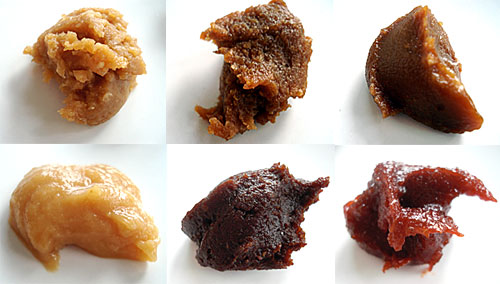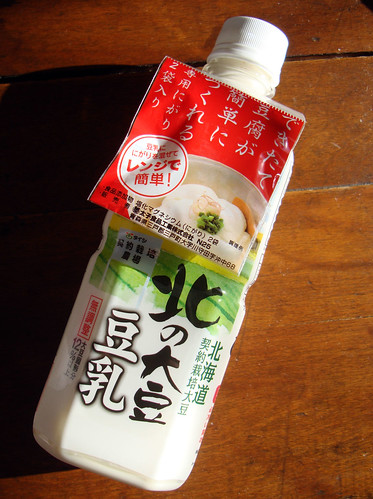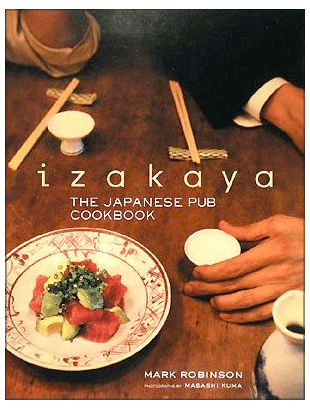Features (articles)
Miso Basics: A Japanese miso primer, looking at different types of miso
[From the archives. This miso primer was published here last September (2008). I've added some notes about miso-based blends, especially sumiso or miso with vinegar.]
This is a post that has been a long time coming. I kept on holding it off until I had a good variety of miso on hand to show photos of. I can't say I have a comprehensive selection to show you, but I hope you will find this article useful anyway.
Miso (味噌、みそ), as you probably know already, is a naturally fermented paste made by combining cooked soy beans, salt, and often some other ingredient such as white or brown rice, barley, and so on. The texture can range from smooth to chunky, and the color from a light yellow-brown to reddish brown to dark chocolate brown, and the flavor ranges from mildly salty and sweet to strong and very salty. It is packed with umami and protein, not to mention all sorts of nutrients.
Miso-like fermented bean products and pastes exist all over Asia, but here I will mainly limit myself to the most commonly used Japanese misos.
Some general rules of miso
The color can be a fairly good indicator of the strength of flavor, age and saltiness of the miso. Generally speaking, the lighter in color of the miso, the sweeter (less salty) it is. Light colored misos are also younger than dark colored ones in general.There are exceptions to this rule, but if you are confronted with a selection and don't know which way to go, it's useful to remember.
The longer a miso is aged, the deeper in flavor it gets, though it can get a bit odd if aged too long. Commercially available miso is usually aged from 6 months to 2 years. (Note: Many misos made by health-oriented companies (e.g. Eden Foods in the U.S., Clearspring in the UK) do not seem to be aged too long, and therefore lack depth of flavor. If you're just eating miso for health reasons you may not care, but otherwise you are forewarned.)
You can keep unopened miso at room temperature indefinitely. Once opened, store well covered in the refrigerator - though it won't go 'off' that fast really. Ideally you want to consume it within a year of purchase. (I've kept miso for 3 years in the fridge without any ill effects, but I don't really recommend you do that!)
Major types of miso by color
Shiromiso (白みそ)or 'white' miso is the generic term for golden-yellow to medium brown miso. It is milder than other kinds of miso, with a slight sweetness. It's the most versatile one for cooking purposes - you can use it for miso soups, miso marinades, and so on. If you can only afford one kind of miso budget-wise or space-wise, get a good shiromiso that is labelled 'medium sweet'.
Akamiso (赤みそ)or 'red' miso is the generic term for miso that is a dark reddish-brown in color. It is usually (but not always!) more salty and assertive in taste than shiromiso. If you see a red-brown miso that is labelled a inakamiso (田舎味噌)or 'country' miso, you can be pretty sure that it will be strong in flavor and fairly salty.
Awasemiso (合わせ味噌)or 'blended' miso is just that, miso that combines two or more different types of miso together. This is also a good general choice if you don't want to assemble a miso collection.
With or without dashi?
Since miso is so often used in conjunction with dashi stock, some misos already have dashi added to them. These are usually labeled dashi iri (だし入り). If you want to add your own homemade dashi, or you are a vegan and want to avoid any fish products in your miso (see vegan dashi), look for additive-free or mutenka (無添加)miso. If you can't tell from the label whether it has dashi or not, look at the ingredient list - an additive free miso should only have soy beans, salt, rice or barley if they are used, and perhaps some fermentation ingredients (usually listed as koji (麹)).
Organic/not-GM?
If you want to be sure to get miso that is made from soy beans that are organically grown and not genetically modified, look for ones that say yuuki (有機). Most if not all miso that say mutenka (無添加)or additive-free are also non-GM . You may also encounter miso that says it's made from kokusan (国産)or domestic (Japanese) soy beans; this usually (thought not always - so check!) means it's made from non-GM, happy soy beans. (See above note about misos made by Western health-oriented companies.)
Gluten free?
Unless the miso contains barley (麦、mugi) or wheat (小麦、komugu) it is gluten-free, unless it has some not-traditional additives.
Some misos to look for by name
You may see a number of 'brand' names for miso, such as Shinshuu, Yamato, etc. Most of these names don't really mean much except to indicate where the miso comes from - the differences are too subtle except for a diehard miso connoisseur. There are a couple that stand out though.
- Hatcho miso (八丁味噌)is a type of miso made in the Tokai region (now the 3 prefectures of Aichi, Mie and Gifu). It was traditionally said to have been served to the emperor and is held in high regard. It's an all-soybean miso, which is about medium on the sweet/strength/saltiness scale, and is a good general purpose miso.
- Saikyo miso (西京味噌) is a golden yellow miso that was traditionally made in the Kyoto/Kansai region. It is naturally sweet - the sweetness comes from the sugar produced as a byproduct of the fermentation process, similar to amazake (甘酒). Makes a good dipping sauce or condiment, and is used as a sweet flavor in baked goods and so on by some Japanese vegan cooks. Does not keep as well as other miso types since it's lower in salt, so you must refrigerate it. It's very expensive! (I noticed that the Nobu restaurant group has a recipe online for 'saikyo' miso, but it uses white sugar! That's just sweet miso sauce, not Saikyo miso.)
- Moromi miso (もろみ味噌)is a mildly salty, chunky miso, usually with added grains of rice or barley that is meant to be eaten as a condiment rather than in cooking. It's used rather like a dip on raw vegetables and things like that. (One of my teachers used to insist that moromi miso on raw cucumbers would make us smarter.)
Miso based sauces or blends
These are not pure misos, but are sauces or blends with miso.
- Sumiso (酢みそ)is miso with added vinegar, sugar and mirin. It's used as a condiment, marinade, and so on.
- Miso blend for marinade, or misozuke (味噌漬け)is miso with added mirin, soy sauce, konbu seaweed, and so on. Commercial blends often have MSG or "flavor enhancers" in them.
How to get a good miso?
As with many things in life, generally speaking the more expensive a miso is, the better it's going to taste. Do be sure you are comparing like-to-like when looking at prices though. Generally, special misos like Saikyo miso, or ones with special additives like brown rice miso, tend to be more expensive than general white, red or blended miso. Also, organic/additive-free misos tend to be a bit more expensive.
The only way to really know if a miso is good or not is to taste it. So, if you are trying out a new to you miso, try to get the smallest package possible and try it out.
You may think me prejudiced, and I probably am, but I do think that miso made in Japan generally tastes better than miso made elsewhere. Not to name names, but I've tried some non-Japanese brands, and they are lacking in depth of flavor, even if they are sometimes more expensive!
Making miso at home
I have not tried this myself yet, so I have nothing to show you, but you can make miso at home. All you need is soy beans, salt, some ko-ji (麹)(a sort of fermented rice starter), a big bucket, space, and patience - since you need to age the miso for 6 months to a year. You can find instructions on the interweb. (Maybe one day I will try making my own...)
What I have in my kitchen now

The top row shows the three misos I use the most: two types of shiromiso, and an awasemiso. One shiromiso is a big chunkier in texture and has brown rice in it; the other shiromiso and the awasemiso are both all-soy bean types. I use any of the three for most if not all the recipes here on Just Hungry or over on Just Bento. There's no good reason for me to have two shiromisos and an awasemiso - I just like trying out stuff.
The second row shows misos I use a lot less. On the left is a Saikyo miso, and in the middle is some quite salty-strong akamiso. I use Saikyo miso in some baking experiments and as a sauce to go with stewed daikon radish and such. The red miso is used for some marinades and some miso soups.
Lastly, since I had a square to fill and I only have 5 kinds of miso on hand at the moment, I've included some Korean gochujang (or kochujang as it's pronounced in Japan), although it's not a miso at all. It is however a fermented soy bean paste with added wheat, spices and so on.As you can see much redder than the 'red' akamiso - since I use it almost as much as miso because I love it so much.
The basics of Japanese cooking and all that
What actually prompted me to finally post this was an article I saw elsewhere that was titled What Is Miso Paste? It stated that miso and rice for Japanese people are like 'meat and potatoes for Americans'. Heh?
Sure, miso is part of Japanese cuisine. But you do not always eat miso, or always have miso soup, with a meal, if that was the analogy they were trying to use. Sure, soup is often served with a meal in Japan, but it can just as well be a clear soup as a miso soup. The real basis of Japanese cooking is rice, dashi and _sa shi su se so_. If you whittle it down to the bare essentials, a bowl of plain, white rice and something salty to go with it makes me feel Japanese through and through.
But enough of my whinging. If you have any questions about miso that I haven't answered here, ask away!
See also
- Japanese Basics: Miso and Miso Soup
- A week of miso soup, day 1, day 2, day 3, day 4, day 5, and wrapup
- Make your own instant miso soup balls
- Miso marinade for meat or fish
- All entries filed under miso on Just Hungry and Just Bento (also try the search function on the site since I may haved missed correctly tagging some miso posts!)




 Once again, Just Hungry is proud to offer a great raffle item for the annual Menu For Hope fund raising event, which will benefit the United Nations World Food Programme.
Once again, Just Hungry is proud to offer a great raffle item for the annual Menu For Hope fund raising event, which will benefit the United Nations World Food Programme.

 When a Japanese person dreams of quitting his or her rat-race job and opening a restaurant, the type of restaurant they usually envision is either a kissaten or kafe (a café-restaurant) or an izakaya. An Izakaya (居酒屋)is a small traditional pub that serves food, rather like a Spanish tapas bar. Many are quite tiny, with just the counter and maybe a few tables. The best ones are run with a lot of passion and love, and have fiercely loyal customers.
When a Japanese person dreams of quitting his or her rat-race job and opening a restaurant, the type of restaurant they usually envision is either a kissaten or kafe (a café-restaurant) or an izakaya. An Izakaya (居酒屋)is a small traditional pub that serves food, rather like a Spanish tapas bar. Many are quite tiny, with just the counter and maybe a few tables. The best ones are run with a lot of passion and love, and have fiercely loyal customers. Welcome to Just Hungry, where we serve authentic Japanese recipes and more! I'm
Welcome to Just Hungry, where we serve authentic Japanese recipes and more! I'm 











